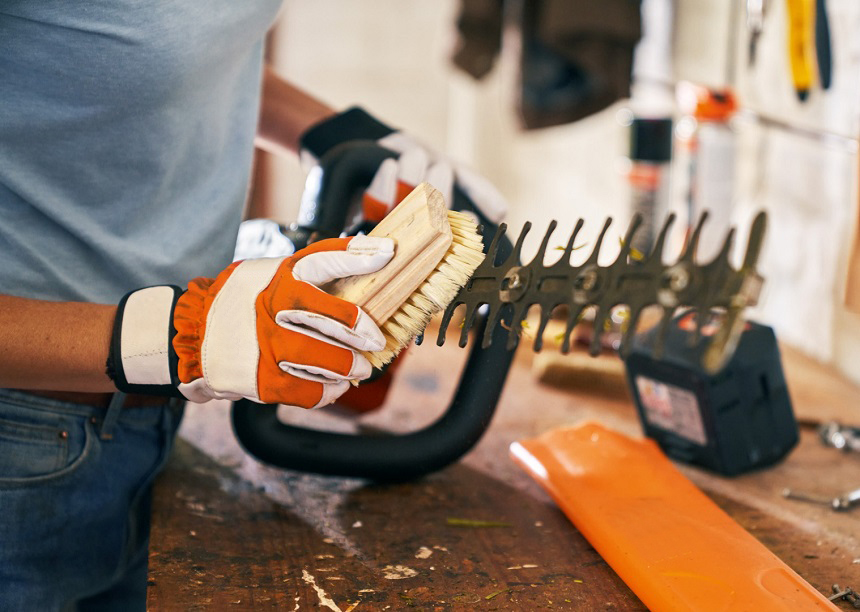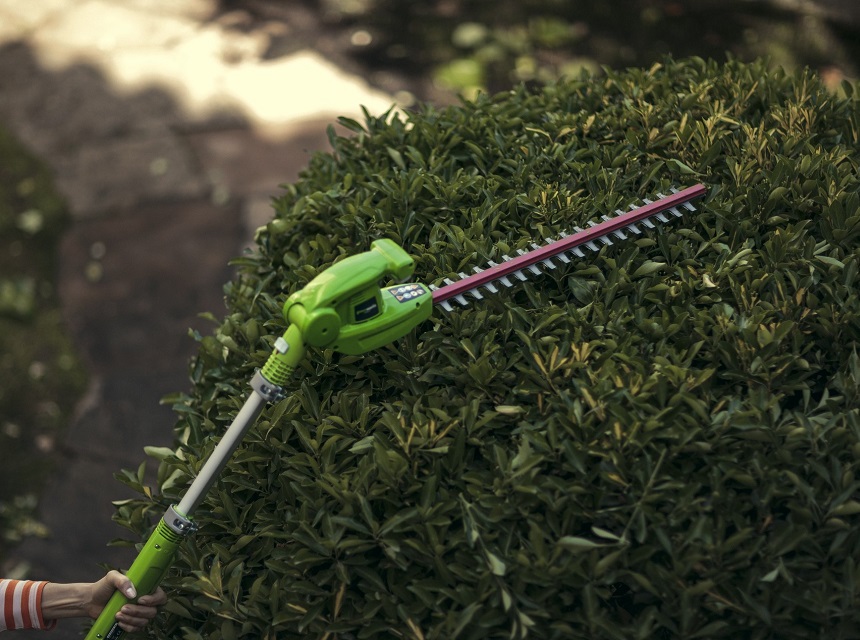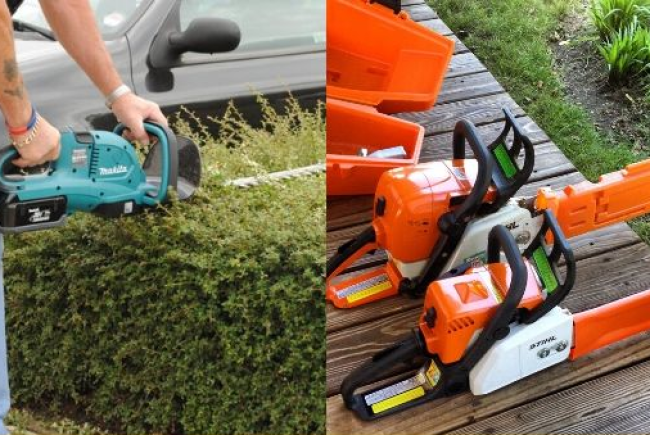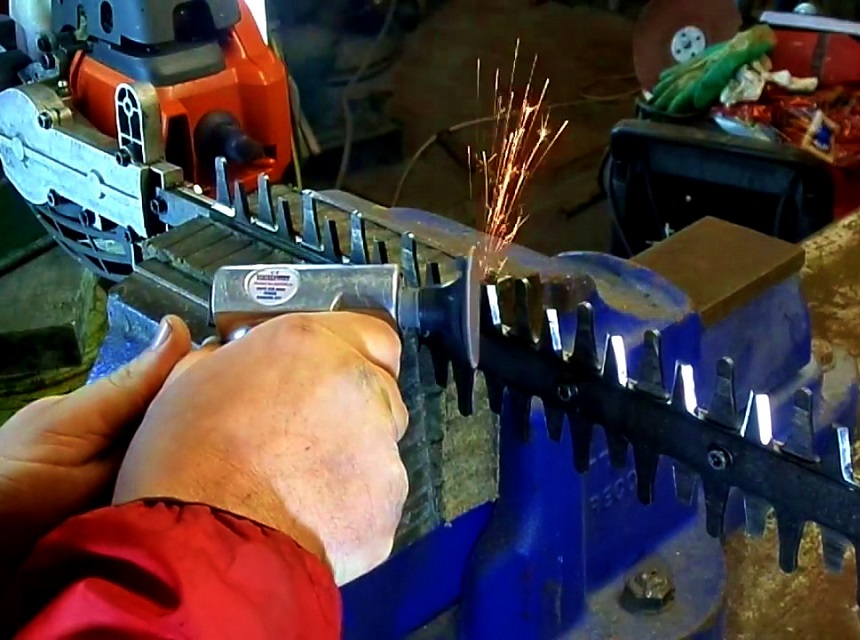
When trimming hedges and bushes, sap, resin, and dirt will always build up on the blades of your hedge trimmer. If the blades are not cleared of the residue, this will affect the cutting performance.
Branches and leaves that get stuck in the gaps between the cutting attachment can also impair the functionality of the device. If you store your hedge trimmer Trusted Source Hedge trimmer - Wikipedia A hedge trimmer, shrub trimmer, or bush trimmer is a gardening tool or machine used for trimming (cutting, pruning) hedges or solitary shrubs (bushes). Different designs as well as manual and powered versions of hedge trimmers exist. en.wikipedia.org uncleaned, rust can also form on the blades. Regular cleaning of the hedge trimmer, therefore, protects your device from premature wear and tear and ensures its efficiency.
In this article, we’ll show you how to clean hedge trimmer blades in simple steps as well as how to maintain the device. All you will need is a brush, soft cloth, maintenance oil, soap, alcohol, resin remover, screwdriver (for deep cleaning), safety goggles, and gloves made of durable material.

First, you need to make sure that you have a few tools and supplies available for cleaning and long-term maintenance. These are basic accessories:
Attention! Before cleaning your device, please switch it off. With the electric hedge trimmer, simply pull the plug. With a gasoline-powered hedge trimmer, you have to remove the spark plug. In the case of cordless tools, remove the battery or remove the activation key.
When it comes to maintenance, the blades require the utmost care because they’re the components that determine the efficiency of the system. But they can rust, get dirty, or blunt quite easily. To clean the blades, you can use a soap solution, alcohol, and kerosene, or use a resin remover.
First, switch off the device – whether it’s an electric or petrol hedge trimmer – and wear safety gloves. When you are not handling the blade, always protect it with its sheath. This way you will make sure that there is no risk of an accident while cleaning the hedge trimmer.
First, before cleaning the hedge trimmer, remove any leaves on the blade by hand to clear it. To do this, remember to use a pair of gloves so as not to get dirty or hurt yourself.
Then, use a hard and stiff brush dipped in soapy water to remove resin residues as well as other dirt from the blade. Once you have cleaned the blade with some soapy water, wipe it with a piece of clean and dry cloth. This removes moisture and prevent corrosion.
Sometimes, a simple splash of soapy water is enough. If, however, the blade is still very dirty, it will be necessary to upgrade to the next level of cleaning below. Above all, it’s not advisable to use water to clean your hedge trimmer. So try the cleaning solutions with alcohol, kerosene, or solvents.
Before cleaning your hedge trimmer, make sure that all its components are in place. Ensure that the bolts are in place. If this is not the case, tighten them without forcing too much so as not to reduce the efficiency of the machine.
Using a brush or soft-bristled paintbrush, remove shavings, pieces of bark, and leaves stuck between the blades. Work slide by slide, then in between for best results.
To rid the blades of your hedge trimmer of post-work resins, you must clean them with a rag and a degreaser. Be careful not to let the degreaser dry on the blades, as this could damage them. Then brush the blades using a mixture of alcohol and kerosene. Ensure there are no traces left on the blades.
Note that you can disinfect the metal with bleach or sprays specially designed by the manufacturer. Apart from that, you can also use specialized solutions, such as the CMT Formula 2050 Blade and Bit Cleaner. Our experts recommend it because it doesn’t contain toxic chemicals, while also being biodegradable, non-flammable, and reusable.
To clean sap from hedge trimmer blades, remove loose leaves and branches with a brush. Then wipe the housing and cutting blades with a cloth soaked in a little oil and spray the blade with a resin dissolving spray. According to most reviews, the ARS Blade Cleaner is by far one of the most effective and time-proven cleaning sprays for hedge trimmer blades.
Reinsert the battery or the spark plugs or connect your hedge trimmer to the power supply and switch them on briefly so that the spray can be distributed on the blade blades.
Maintenance doesn’t end with the cleaning of the blades. You have to lubricate and oil them.
Immediately after cleaning the hedge trimmer, lubrication follows. It is essential to prevent rust from forming. Lubrication also helps to keep the hedge trimmer running smoothly. Oil and fat displace water reliably and for a long time.
If the cutting blades are coated with oil, no rust can form because no water from the air can penetrate them.
Most manufacturers recommend their own maintenance oil for their hedge trimmers, specially tailored to the design of their models.
Just apply the oil on the surface of the blades and then switch on the hedge trimmer and run it so that the oil can go round.
A hedge trimmer gets dirty quickly. Leaves and residues get stuck in the blades and have a negative effect on the cutting capacity. If the hedge trimmer is stored in this way, the blades can rust. We recommend cleaning your hedge trimmer regularly and after use.
Deep cleaning is advisable before a longer storage period. When cleaning your hedge trimmer, there are two things you should pay attention to: unplug the hedge trimmer or remove the battery so that it cannot start under any circumstances. It is also essential to wear gloves for cleaning and for all other maintenance needs.
For petrol hedge trimmers, also clean the air filter, fuel tank, and suction opening. Longer downtimes have different effects on petrol and cordless tools.





